AWM137 2/1 - Historical information and general development of the RAAF Nursing Service - Notes of History of the RAAF Nursing Service 1940-1944 - Part 7
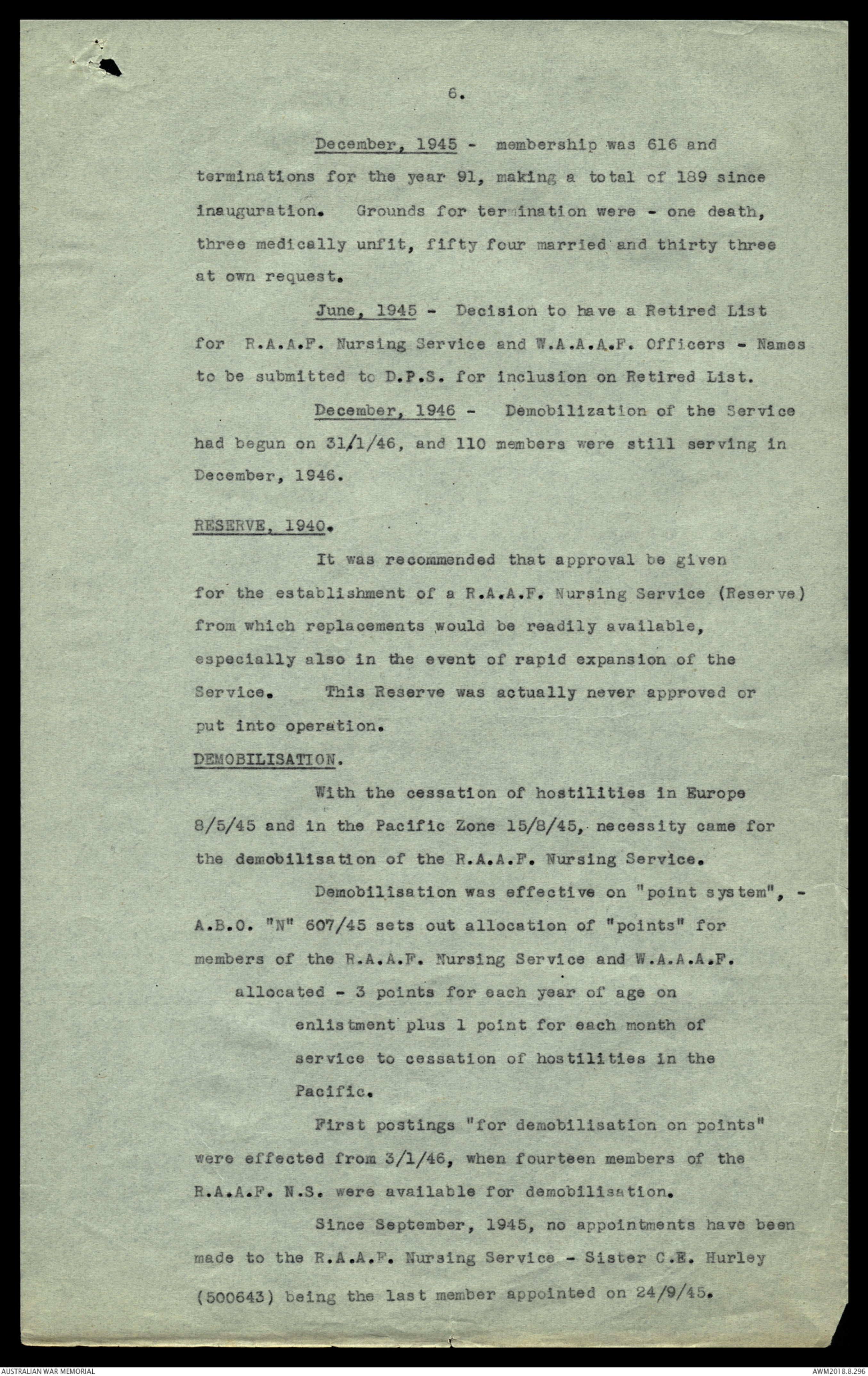
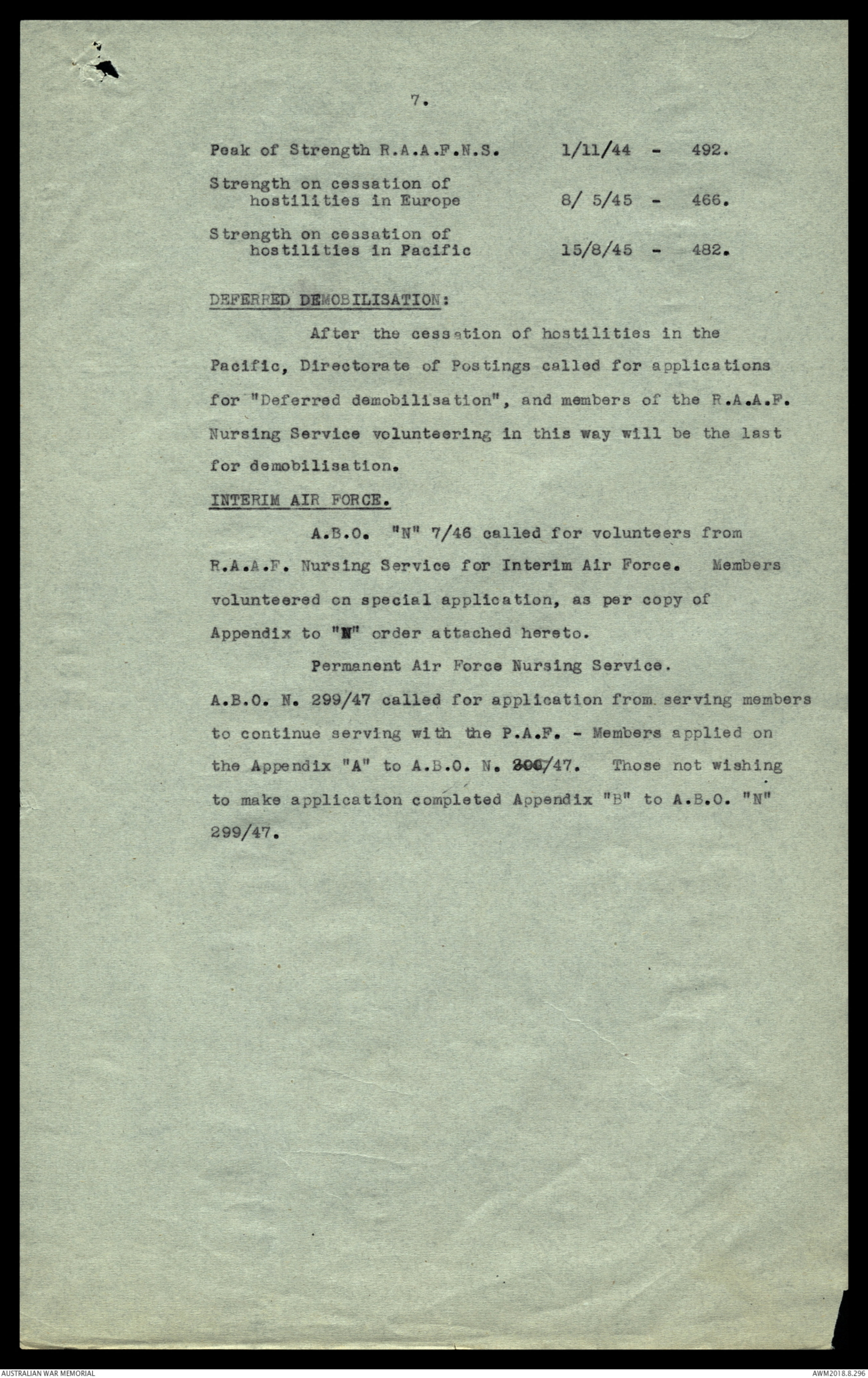

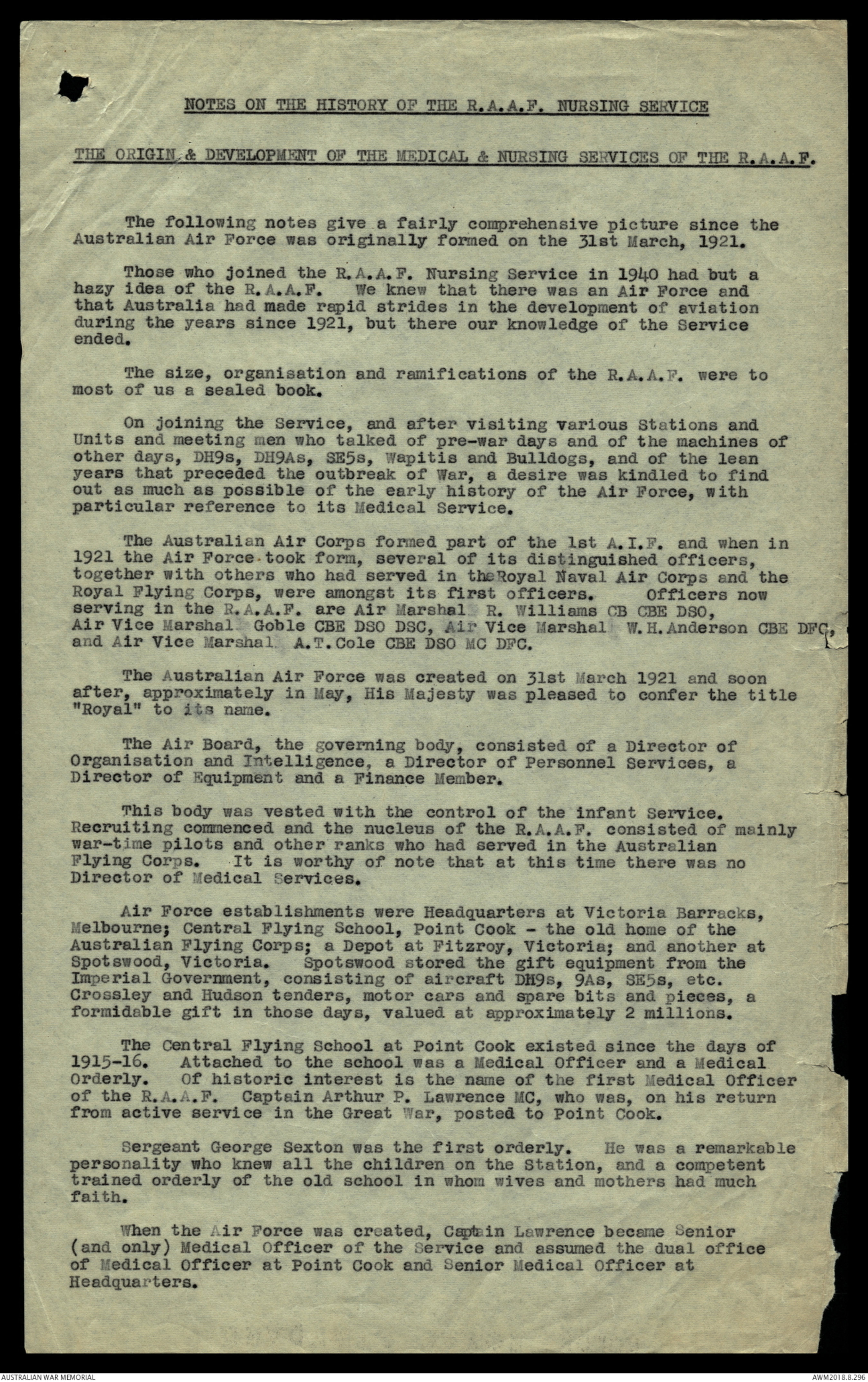
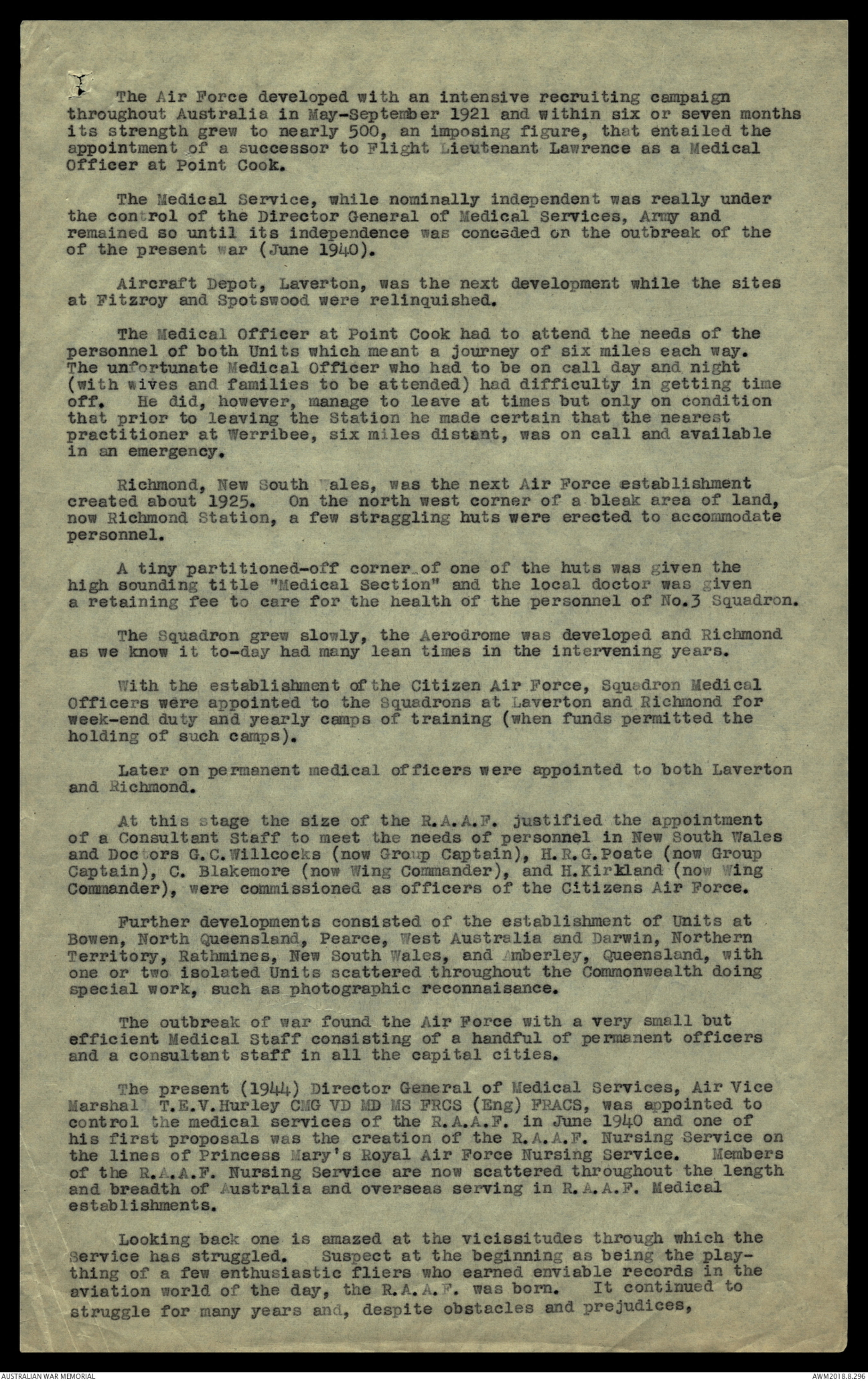
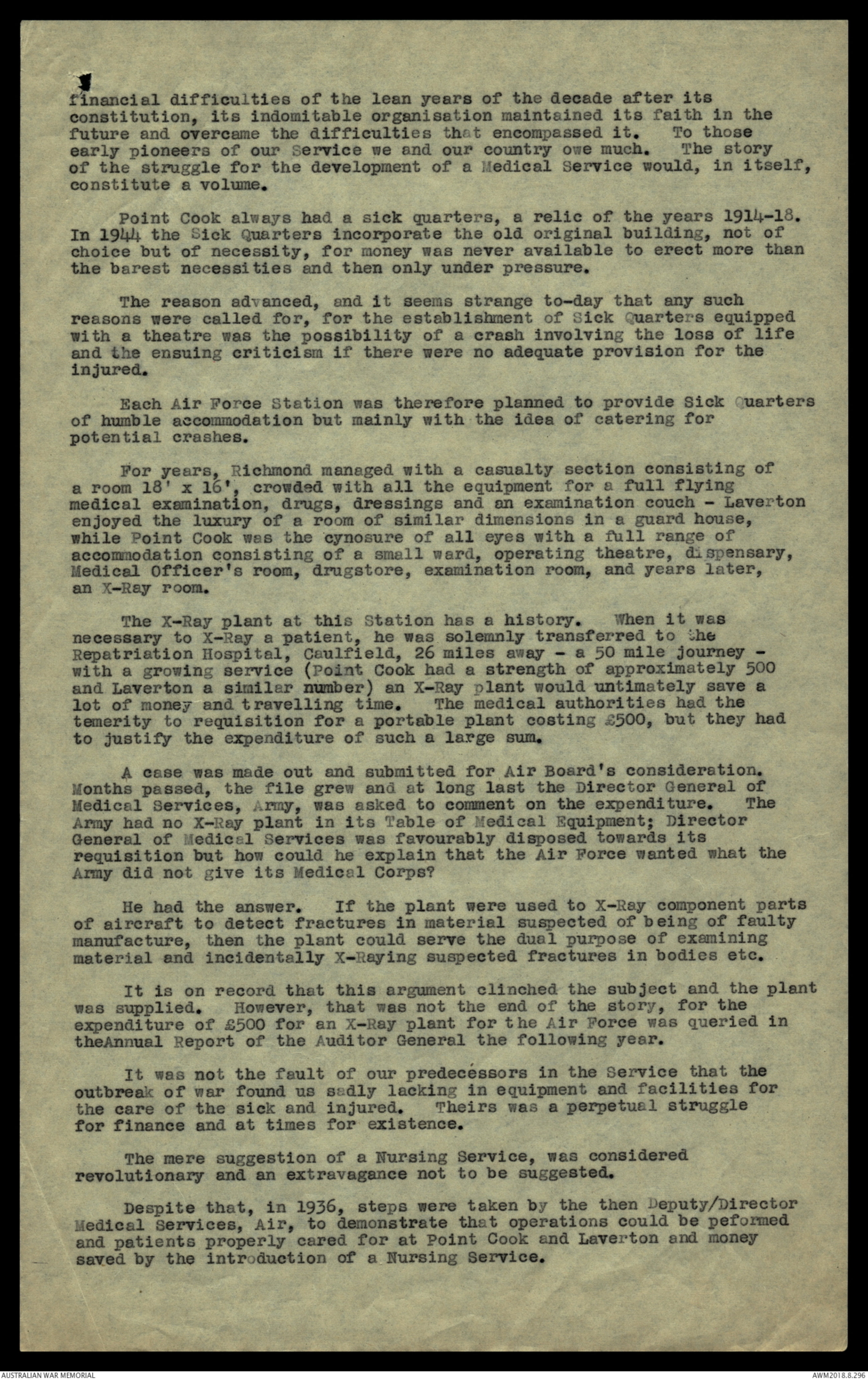
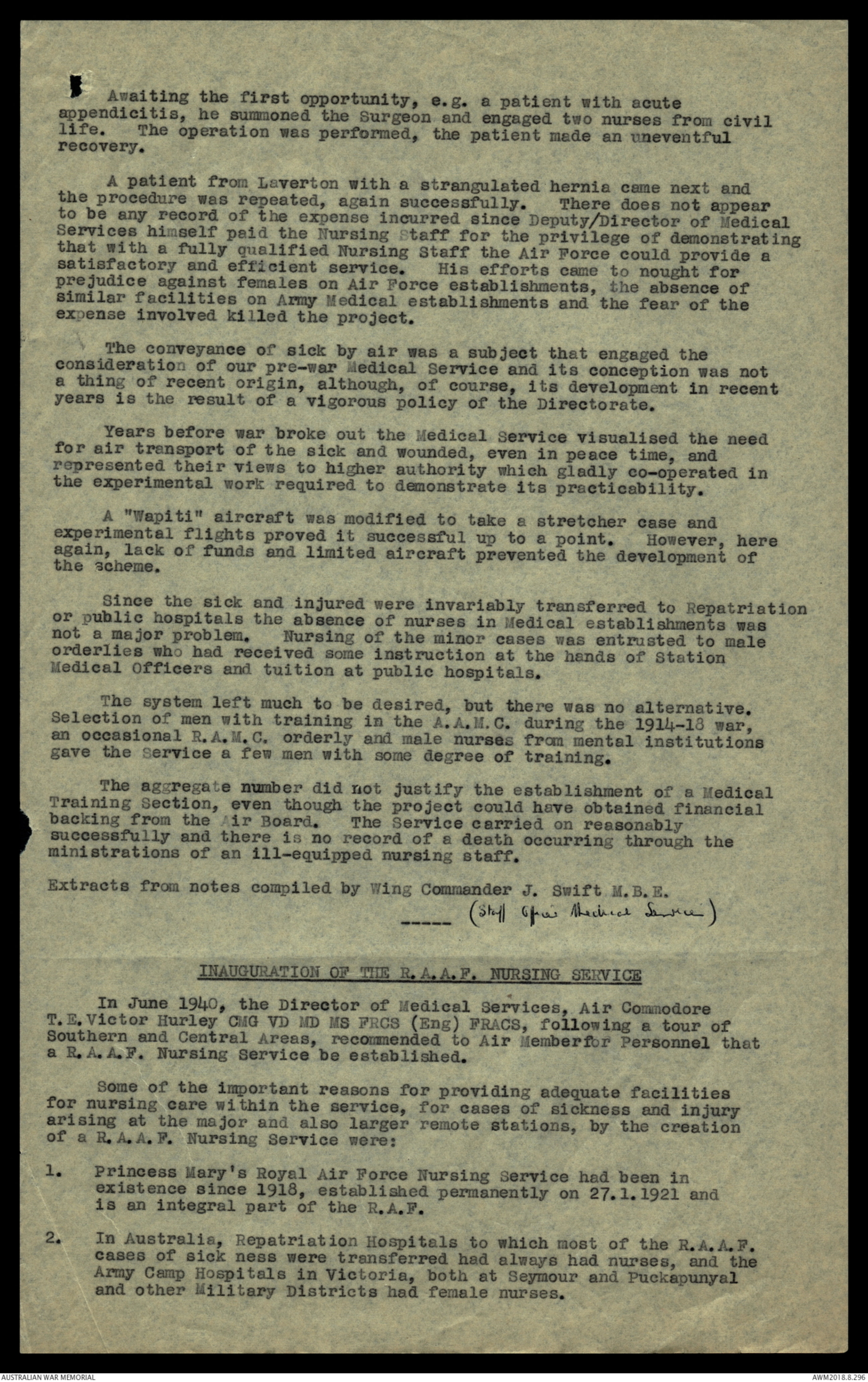
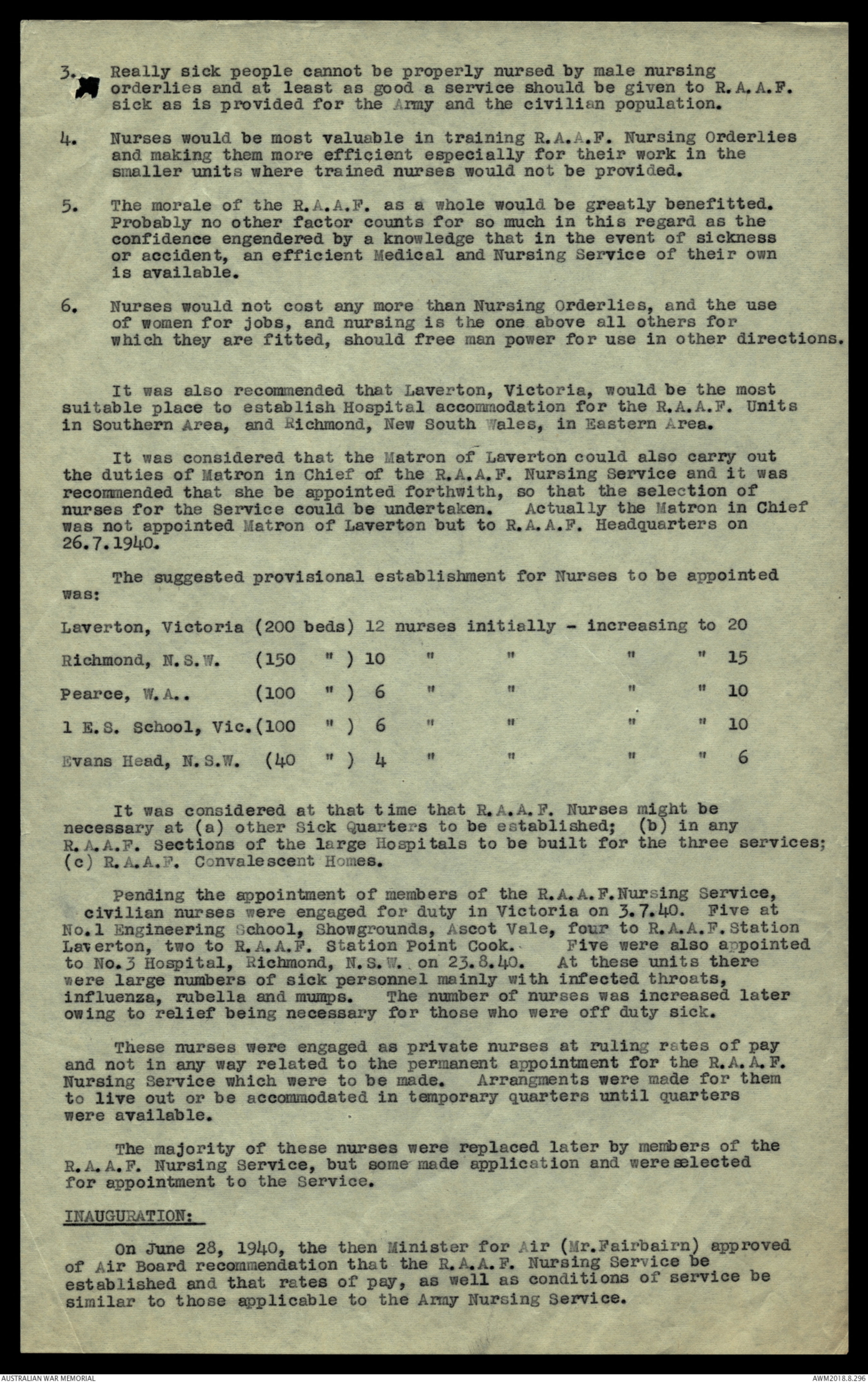
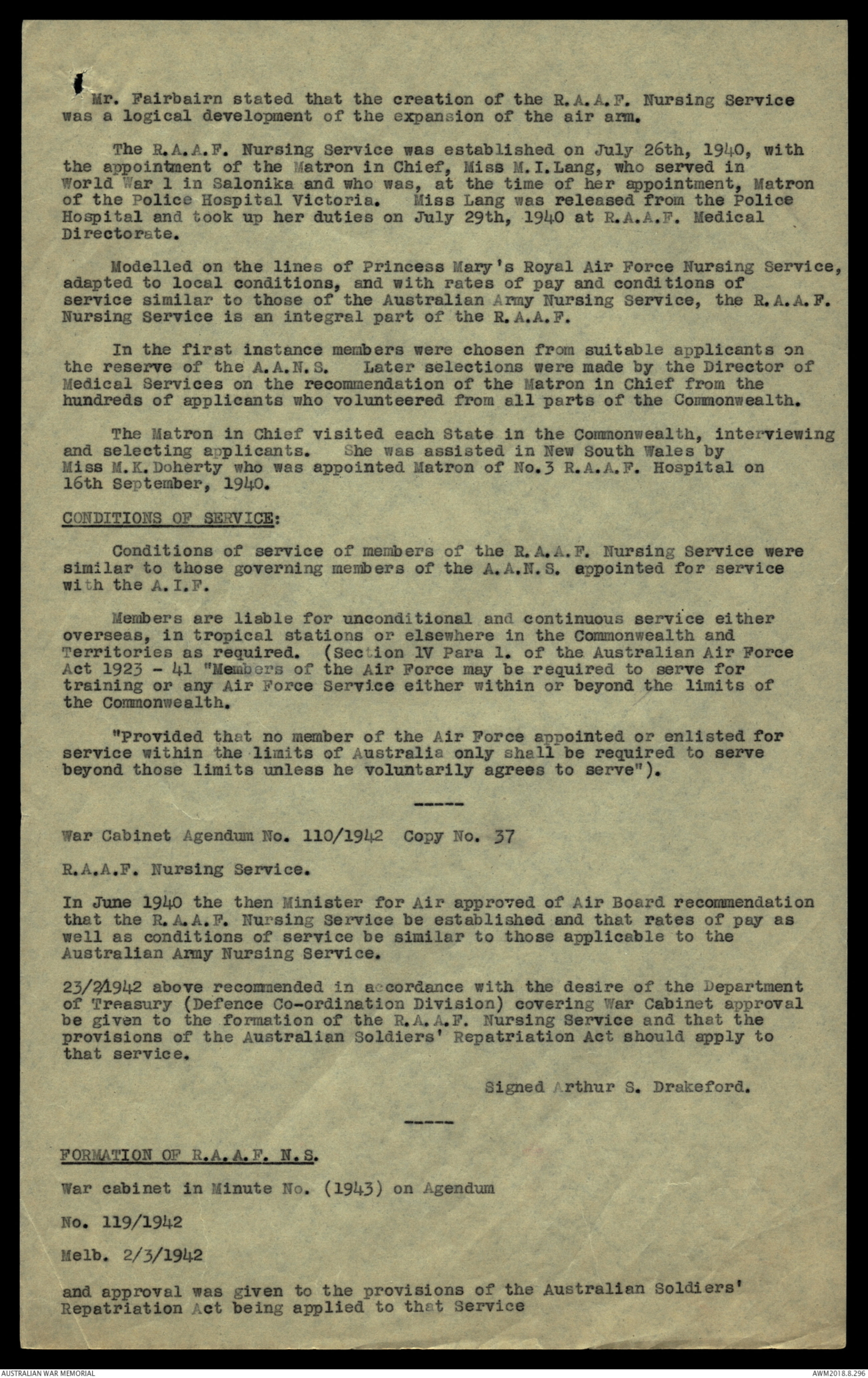
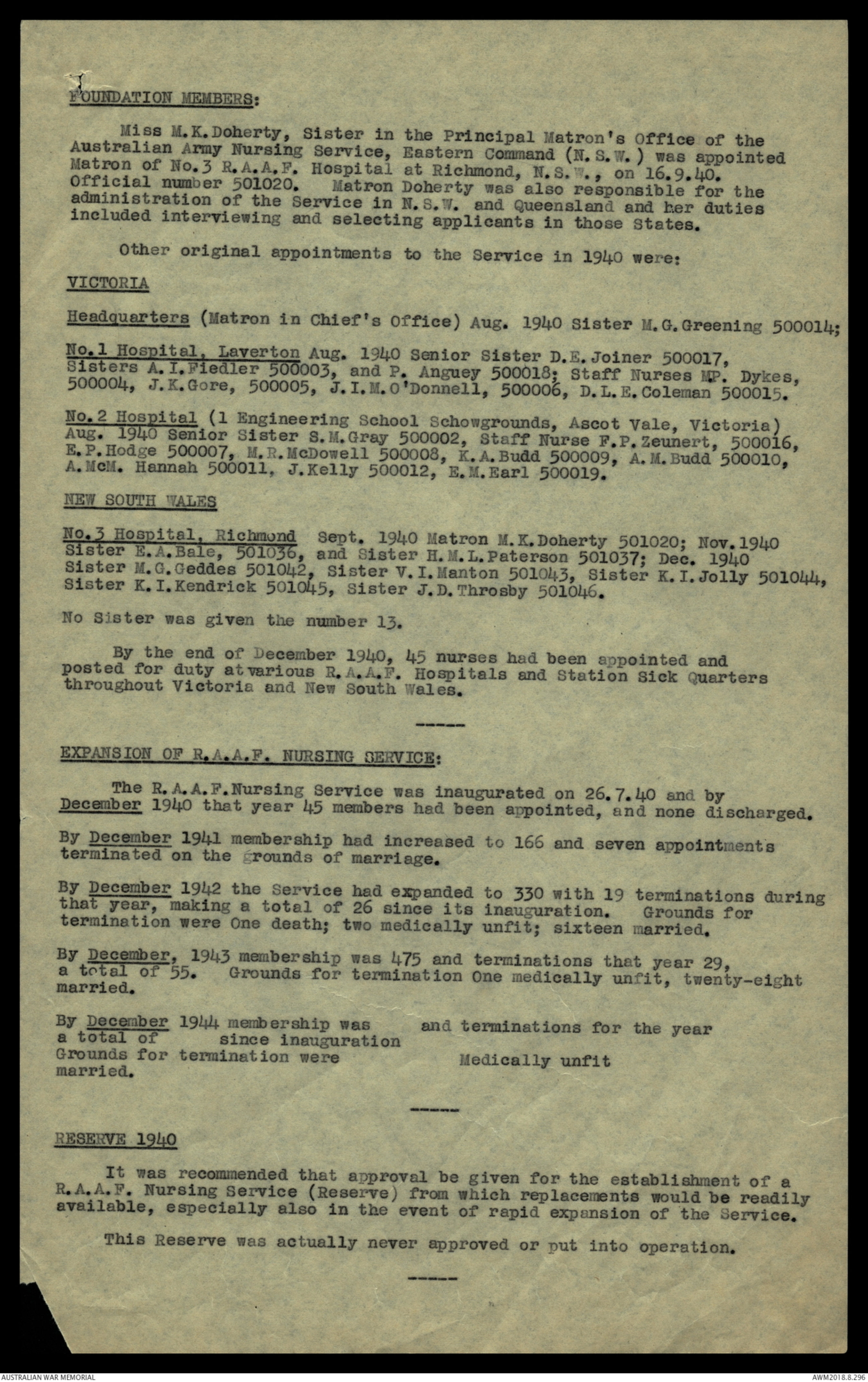
6.
December, 1945 - membership was 616 and
terminations for the year 91, making a total of 189 since
inauguration. Grounds for termination were - one death,
three medically unfit, fifty four married and thirty three
at own request.
June, 1945 - Decision to have a Retired List
for R.A.A.F. Nursing Service and W.A.A.A.F. Officers - Names
to be submitted to D.P.S. for inclusion on Retired List.
December, 1946 - Demobilization of the Service
had begun on 31/1/46, and 110 members were still serving in
December, 1946.
RESERVE, 1940.
It was recommended that approval be given
for the establishment of a R.A.A.F. Nursing Service (Reserve)
from which replacements would be readily available,
especially also in the event of rapid expansion of the
Service. This Reserve was actually never approved or
put into operation.
DEMOBILISATION.
With the cessation of hostilities in Europe
8/5/45 and in the Pacific Zone 15/8/45, necessity came for
the demobilisation of the R.A.A.F. Nursing Service.
Demobilisation was effective on "point system", -
A.B.O. "N" 607/45 sets out the allocation of "points" for
members of the R.A.A.F. Nursing Service and W.A.A.A.F.
allocated - 3 points for each year of age on
enlistment plus 1 point for each month of
service to cessation of hostilities in the
Pacific.
First postings "for demobilisation on points"
were effected from 3/1/46, when fourteen members of the
R.A.A.F. N.S. were available for demobilisation.
Since September, 1945, no appointments have been
made to the R.A.A.F. Nursing Service - Sister C.E. Hurley
(500643) being the last member appointed on 24/9/45.
7.
Peak of Strength R.A.A.F.N.S. 1/11/44 - 492.
Strength on cessation of
hostilities in Europe 8/ 5/45 - 466.
Strength on cessation of
hostilities in Pacific 15/8/45 - 482.
DEFERRED DEMOBILISATION:
After the cessation of hostilities in the
Pacific, Directorate of Postings called for applications
for "Deferred demobilisation", and members of the R.A.A.F.
Nursing Service volunteering in this way will be the last
for demobilisation.
INTERIM AIR FORCE.
A.B.O. "N" 7/46 called for volunteers from
R.A.A.F. Nursing Service for Interim Air Force. Members
volunteered on special application, as per copy of
Appendix to "N" order attached hereto.
Permanent Air Force Nursing Service.
A.B.O. N. 299/47 called for application from serving members
to continue serving with the P.A.F. - Members applied on
the Appendix "A" to A.B.O. N. 300/47. Those not wishing
to make application completed Appendix "B" to A.B.O. "N"
299/47
NOTES ON THE HISTORY
OF THE
ROYAL AUSTRALIAN AIR FORCE NURSING SERVICE
NOTES ON THE HISTORY OF THE R.A.A.F. NURSING SERVICE
THE ORIGIN & DEVELOPMENT OF THE MEDICAL & NURSING SERVICE OF THE R.A.A.F.
The following notes give a fairly comprehensive picture since the
Australian Air Force was originally formed on the 31st March, 1921.
Those who joined the R.A.A.F. Nursing Service in 1940 had but a
hazy idea of the R.A.A.F. We knew that there was an Air Force and
that Australia had made rapid strides in the development of aviation
during the years since 1921, but there our knowledge of the Service
ended.
The size, organisation and ramifications of the R.A.A.F. were to
most of us a sealed book.
On joining the Service, and after visiting various Stations and
Units and meeting men who talked of pre-war days and of the machines of
other days, DH9s, DH9As, SE5a, Wapitis and Bulldogs, and of the lean
years that preceded the outbreak of War, a desire was kindled to find
out as much as possible of the early history of the Air Force, with
particular reference to its Medical Service.
The Australian Air Corps formed part of the 1st A.I.F. and when in
1921 the Air Force took form, several of its distinguished officers,
together with others who had served in theRoyal Naval Air Corps and the
Royal Flying Corps, were amongst its first officers. Officers now
serving in the R.A.A.F. are Air Marshal R. Williams CB CBE DSO,
Air Vice Marshal Goble CBE DSO DSC, Air Vice Marshal W.H.Anderson CBE DFC,
and Air Vice Marshal A.T. Cole CBE DSO MC DFC.
The Australian Air Force was created on 31st March 1921 and soon
after, approximately in May, His Majesty was pleased to confer the title
"Royal" to its name.
The Air Board, the governing body, consisted of a Director of
Organisation and Intelligence, a Director of Personnel Services, a
Director of Equipment and a Finance Member.
This body was vested with the control of the infant Service.
Recruiting commenced and the nucleus of the R.A.A.F. consisted of mainly
war-time pilots and other ranks who had served in the Australian
Flying Corps. It is worthy of note that at this time there was no
Director of Medical Services.
Air Force establishments were Headquarters at Victoria Barracks,
Melbourne; Central Flying School, Point Cook - the old home of the
Australian Flying Corps; a Depot at Fitzroy, Victoria; and another at
Spotswood, Victoria. Spotswood stored the gift equipment from the
Imperial Government, consisting of aircraft DH9s, 9As, SE5s, etc.
Crossley and Hudson tenders, motor cars and spare bits and pieces, a
formidable gift in those days, valued at approximately 2 millions.
The Central Flying School at Point Cook existed since the days of
1915-16. Attached to the school was a Medical Officer and a Medical
Orderly. Of historic interest is the name of the first Medical Officer
of the R.A.A.F. Captain Arthur P. Lawrence MC, who was, on his return
from active service in the Great War, posted to Point Cook.
Sergeant George Sexton was the first orderly. He was a remarkable
personality who knew all the children on the Station, and a competent
trained orderly of the old school in whom wives and mothers had much
faith.
When the Air Force was created, Captain Lawrence became Senior
(and only) Medical Officer of the Service and assumed the dual office
of Medical Officer at Point Cook and Senior Medical Officer at
Headquarters.
The Air Force developed with an intensive recruiting campaign
throughout Australia in May-September 1921 and within six or seven months
its strength grew to nearly 500, an imposing figure, that entailed the
appointment of a successor to Flight Lieutenant Lawrence as a Medical
Officer at Point Cook.
The Medical Service, while nominally independent was really under
the control of the Director General of Medical Services, Army and
remained so until its independence was conceded on the outbreak of the
of the present war (June 1940).
Aircraft Depot, Laverton, was the next development while the sites
at Fitzroy and Spotswood were relinquished.
The Medical Officer at Point Cook had to attend the needs of the
personnel of both Units which meant a journey of six miles each way.
The unfortunate Medical Officer who had to be on call day and night
(with wives and families to be attended) had difficulty in getting time
off. He did, however, manage to leave at times but only on condition
that prior to leaving the Station he made certain that the nearest
practitioner at Werribee, six miles distant, was on call and available
in an emergency.
Richmond, New South Wales, was the next Air Force establishment
created about 1925. On the north west corner of a bleak area of land,
now Richmond Station, a few struggling huts were erected to accommodate
personnel.
A tiny partitioned-off corner of one of the huts was given the
high sounding title "Medical Section" and the local doctor was given
a retaining fee to care for the health of the personnel of No.3 Squadron.
The Squadron grew slowly, the Aerodrome was developed and Richmond
as we know it to-day had many lean times in the intervening years.
With the establishment of the Citizen Air Force, Squadron Medical
Officers were appointed to the Squadrons at Laverton and Richmond for
week-end duty and yearly camps of training (when funds permitted the
holding of such camps).
Later on permanent medical officers were appointed to both Laverton
and Richmond.
At this stage the size of the R.A.A.F. justified the appointment
of a Consultant Staff to meet the needs of personnel in New South Wales
and Doctors G.C.Willcocks (now Group Captain), H.R.G.Poate (now Group
Captain), C. Blakemore (now Wing Commander), and H.Kirkland (now Wing
Commander), were commissioned as officers of the Citizens Air Force.
Further developments consisted of the establishment of Units at
Bowen, North Queensland, Pearce, West Australia and Darwin, Northern
Territory, Rathmines, New South Wales and Amberley, Queensland. with
one or two isolated Units scattered throughout the Commonwealth doing
special work, such as photographic reconnaisance.
The outbreak of war found the Air Force with a very small but
efficient Medical Staff consisting of a handful of permanent officers
and a consultant staff in all the capital cities.
The present (1944) Director General of Medical Services, Air Vice
Marshal T.E.V.Hurley CMG VD MD MS FRCS (Eng) FRACS was appointed to
control the medical services of the R.A.A.F. in June 1940 and one of
his first proposals was the creation of the R.A.A.F. Nursing Service on
the lines of Princess Mary's Royal Air Force Nursing Service. Members
of the R.A.A.F. Nursing Service are now scattered throughout the length
and breadth of Australia and overseas serving in R.A.A.F. Medical
establishments.
Looking back one is amazed at the vicissitudes through which the
service has struggled. Suspect at the beginning as being the plaything
of a few enthusiastic fliers who earned enviable records in the
aviation world of the day, the R.A.A.F. was born. It continued to
struggle for many years and, despite obstacles and prejudices,
financial difficulties of the lean years of the decade after its
constitution, its indomitable organisation maintained its faith in the
future and overcame the difficulties that encompassed it. To those
early pioneers of our Service we and our country owe much. The story
of the struggle for the development of a Medical Service would, in itself,
constitute a volume.
Point Cook always had a sick quarters, a relic of the years 1914-18.
In 1944 the Sick Quarters incorporate the old original building, not of
choice but of necessity, for money was never available to erect more than
the barest necessities and then only under pressure.
The reason advanced, and it seems strange to-day that any such
reasons were called for, for the establishment of Sick Quarters equipped
with a theatre was the possibility of a crash involving the loss of life
and the ensuing criticism if there was no adequate provision for the
injured.
Each Air Force Station was therefore planned to provide Sick Quarters
of humble accommodation but mainly with the idea of catering for
potential crashes.
For years, Richmond managed with a casualty section consisting of
a room 18' x 16', crowded with all the equipment for a full flying
medical examination, drugs, dressings and an examination couch - Laverton
enjoyed the luxury of a room of similar dimensions in a guard house.
while Point Cook was the cynosure of all eyes with a full range of
accommodation consisting of small ward, operating theatre, dispensary,
Medical Officer's room, drugstore, examination room, and years later,
an X-Ray room.
The X-Ray plant at this Station has a history. When it was
necessary to X-Ray a patient, he was solemnly transferred to the
Repatriation Hospital, Caufield, 26 miles away - a 50 mile journey -
with a growing service (Point Cook had a strength of approximately 500
and Laverton a similar number) and X-Ray plant would untimately save a
lot of money and travelling time. The medical authorities had the
temerity to requisition for a portable plant costing £500, but they had
to justify the expenditure of such a large sum.
A case was made out and submitted for Air Board's consideration.
Months passed, the file grew and at long last the Director General of
Medical Services, Army, was asked to comment on the expenditure. The
Army had no X-Ray plant in its Table of Medical Equipment; Director
General of Medical services was favourably disposed towards its
requisition but how could he explain that the Air Force wanted what the
Army did not give its Medical Corps?
He had the answer. If the plant were used to X-Ray component parts
of aircraft to detect fractures in material suspected of being of faulty
manufacture, then the plant could serve the dual purpose of examining
material and incidentally X-Raying suspected fractures in bodies etc.
It is on record that this argument clinched the subject and the plant
was supplied. However, that was not the end of the story, for the
expenditure of £500 for an X-Ray plant for the Air Force was queried in
theAnnual Report of the Auditor General of the following year.
It was not the fault of our predecessors in the Service that the
outbreak of war found us sadly lacking in equipment and facilities for
the care of the sick and injured. Theirs was a perpetual struggle
for finance and at times for existence.
The mere suggestion of a Nursing Service, was considered
revolutionary and an extravagance not to be suggested.
Despite that, in 1936, steps were taken by then Deputy/Director
Medical Services, Air, to demonstrate that operations could be performed
and patients properly cared for at Point Cook and Laverton and money
saved by the introduction of a Nursing Service.
Awaiting the first opportunity, e.g. a patient with acute
appendicitis, he summoned the Surgeon and engaged two nurses from civil
life. The operation was performed, the patient made an uneventful
recovery.
A patient from Laverton with a strangulated hernia came next and
the procedure was repeated, again successfully. There does not appear
to be any record of the expense incurred since Deputy/Director of Medical
Services himself paid the Nursing Staff for the privilege of demonstrating
that with a fully qualified Nursing Staff the Air Force could provide a
satisfactory and efficient service. His efforts came to nought for
prejudice against females on Air Force establishments, the absence of
similar facilities on Army Medical establishments and the fear of the
expense involved killed the project.
The conveyance of sick by air was a subject that engaged the
consideration of our pre-war Medical Service and its conception was not
a thing of recent origin, although, of course, its development in recent
years is the result of a vigorous policy of the Directorate.
Years before war broke out the Medical Service visualised the need
for air transport of the sick and wounded, even in peace time, and
represented their views to higher authority which gladly co-operated in
the experimental work required to demonstrate its practicability.
A "Wapiti" aircraft was modified to take a stretcher case and
experimental flights proved it successful up to a point. However, here
again, lack of funds and limited aircraft prevented the development of
the scheme.
Since the sick and injured invariably transferred to Repatriation
or public hospitals the absence of nurses in Medical establishments was
not a major problem. Nursing of the minor cases entrusted to male
orderlies who had received some instruction at the hands of Station
Medical Officers and tuition at public hospitals.
The system was left much to be desired but there was no alternative.
Selection of men with training in the A.A.M.C. during the 1914-18 war,
an occasional R.A.M.C. orderly and male nurses from mental institutions
gave the Service a few men with some degree of training.
The aggregate number did not justify the establishment of a Medical
Training Section, even though the project could have obtained financial
backing from the Air Board. The Service carried out reasonably
successfully and there is no record of a death occurring through the
ministrations of an ill-equipped nursing staff.
Extracts from notes complied by Wing Commander J. Swift M.B.E.
[*(Staff Officer Medical Services)*]
INAUGURATION OF THE R.A.A.F. NURSING SERVICE
In June 1940, the Director of Medical Services, Air Commodore
T.E. Victor Hurley CMG VD MD MS FRCS (Eng) FRACS, following a tour of
Southern and Central Areas, recommended to Air Memberfor Personnel that
a R.A.A.F. Nursing Service be established.
Some of the important reasons for providing adequate facilities
for nursing care within the service, for cases of sickness and injury
arising at the major and also larger remote stations, by the creation
of a R.A.A.F. Nursing Service were:
1. Princess Mary's Royal Air Force Nursing Service had been in
existence since 1918, established permanently on 27.1.1921 and
is an integral part of the R.A.F.
2. In Australia, Repatriation Hospitals to which most of the R.A.A.F.
cases of sick ness were transferred had always had nurses, and the
Army Camp Hospitals in Victoria, both at Seymour and Puckapunyal
and other Military Districts had female nurses.
3. Really sick people cannot be properly nursed by male nursing
orderlies and at least as good a service should be given to R.A.A.F.
sick as is provided for the Army and civilian population.
4. Nurses would be most valuable in training R.A.A.F. Nursing Orderlies
and making them more efficient especially for their work in the
smaller units where trained nurses would not be provided.
5. The morale of the R.A.A.F. as a whole would be greatly benefitted.
Probably no other factor counts for so much in this regard as the
confidence engendered by a knowledge that in the event of sickness
or accident, an efficient Medical and Nursing Service of their own
is available.
6. Nurses would not cost any more than Nursing Orderlies, and the use
of women for jobs, and nursing is the one above all others for
which they are fitted, should free man power for use in other directions.
It was also recommended that Laverton, Victoria, would be the most
suitable place to establish Hospital accommodation for the R.A.A.F Units
in Southern Area, and Richmond, New South Wales, in Eastern Area.
It was considered that the Matron of Laverton could also carry out
the duties of Matron in Chief of the R.A.A.F. Nursing Service and it was
recommended that she be appointed forthwith, so that the selection of
nurses for the Service could be undertaken. Actually the Matron in Chief
was not appointed Matron of Laverton but to R.A.A.F Headquarters on
26.7.1940.
The suggested provisional establishment for Nurses to be appointed
was:
Laverton, Victoria (200 beds) 12 nurses initially - increasing to 20
Richmond, N.S.W. (150 " ) 10 " " - " " 15
Pearce, W.A.. (150 " ) 6 " " - " " 10
1 E.S. School, Vic. (150 " ) 6 " " - " " 10
Evans Head, N.S.W. (40 " ) 4 " " - " " 6
It was considered at that time that R.A.A.F. Nurses might be
necessary at (a) other Sick Quarters to be established; (b) in any
R.A.A.F. Sections of the large Hospitals to be built for the three services;
(c) R.A.A.F. Convalescent Homes.
Pending the appointment of members of the R.A.A.F.Nursing Service,
civilian nurses were engaged for duty in Victoria on 3.7.40. Five at
No. 1 Engineering School, Showgrounds, Ascot Vale, four to R.A.A.F.Station
Laverton, two to R.A.A.F. Station Point Cook. Five were also appointed
to No. 3 Hospital, Richmond, N.S.W. on 23.8.40. At these units there
were large numbers of sick personnel mainly with infected throats,
influenza, rubella and mumps. The number of nurses was increased later
owing to relief being necessary for those who were off duty sick.
These nurses were engaged as private nurses at ruling rates of pay
and not in any way related to the permanent appointment for the R.A.A.F.
Nursing Service which were to be made. Arrangements were made for them
to live out or be accommodated in temporary quarters until quarters
were available.
The majority of these nurses were replaced later by members of the
R.A.A.F. Nursing Service, but some application and were selected
for appointment to the Service.
INAUGURATION:
On June 28, 1940, the then Minister for Air (Mr.Fairbairn) approved
of Air Board recommendation that the R.A.A.F. Nursing Service be
established and that rates of pay, as well as conditions of service be
similar to those applicable to the Army Nursing Service.
Mr. Fairbairn stated that the creation of the R.A.A.F. Nursing Service
was a logical development of the expansion of the air arm.
The R.A.A.F. Nursing Service was established on July 26th, 1940, with
the appointment of the Matron of Chief, Miss M.I.Lang, who served in
World War 1 in Salonika and who was, at the time of her appointment, Matron
of the Police Hospital Victoria. Miss Lang was released from the Police
Hospital and took up her duties on July 29th, 1940 at R.A.A.F. Medical
Directorate.
Modelled on the lines of Princess Mary's Royal Air Force Nursing Service,
adapted to local conditions, and with rates of pay and conditions of
service similar to those of the Australian Army Nursing Service, the R.A.A.F.
Nursing Service is an integral part of the R.A.A.F.
In the first instance members were chosen from suitable applicants on
the reserve of the A.A.N.S. Later selections were made by the Director of
Medical Services on the recommendation of the Matron in Chief from the
hundreds of applicants who volunteered from all parts of the Commonwealth.
The Matron in Chief visited each State in the Commonwealth, interviewing
and selecting applicants. She was assisted in New South Wales by
Miss M.K. Doherty who was appointed Matron of No.3 R.A.A.F. Hospital on
16th September, 1940.
CONDITIONS OF SERVICE:
Conditions of service of members of the R.A.A.F. Nursing Service were
similar to those governing members of the A.A.N.S. appointed for service
with the A.I.F.
Members are liable for unconditional and continuous service either
overseas, in tropical stations or elsewhere in the Commonwealth and
Territories as required. (Section IV Para 1. of the Australian Air Force
Act 1923 - 41 "Members of the Air Force may be required to serve for
training of any Air Force Service either within or beyond the limits of
the Commonwealth.
"Provided that no member of the Air Force appointed or enlisted for
service within the limits of Australia only shall be required to serve
beyond those limits unless he voluntarily agrees to serve").
War Cabinet Agendum No. 110/1942 Copy No. 37
R.A.A.F Nursing Service.
In June 1940 the then Minister for Air approved of Air Board recommendation
that the R.A.A.F. Nursing Service be established and that rates of pay as
well as conditions of service be similar to those applicable to the
Australian Army Nursing Service.
23/2/1942 above recommended in accordance with the desire of the Department
of Treasury (Defence Co-ordination Division) covering War Cabinet approval
be given to the formation of the R.A.A.F. Nursing Service and that the
provisions of the Australian Soldiers' Repatriation Act should apply to
that service.
Signed Arthur S. Drakeford.
FORMATION OF R.A.A.F. N.S.
War cabinet in Minute No. (1943) on Agendum
No. 119/1942
Melb. 2/3/1942
and approval was given to the provisions of the Australian Soldiers'
Repatriation Act being applied to that Service
FOUNDATION MEMBERS:
Miss M.K. Doherty, Sister in the Principal Matron's Office of the
Australian Army Nursing Service, Eastern Command (N.S.W.) was appointed
Matron of No.3 R.A.A.F. Hospital at Richmond, N.S.W., on 16.9.40.
Official number 501020. Matron Doherty was also responsible for the
administration of the Service in N.S.W. and Queensland and her duties
included interviewing and selecting applicants in those States.
Other original appointments to the Service in 1940 were:
VICTORIA
Headquarters (Matron in Chief's Office) Aug. 1940 Sister M.G.Greening 500014;
No.1 Hospital, Laverton Aug. 1940 Senior Sister D.E. Joiner 500017,
Sisters A.I.Fielder 500003, and P. Anguey 500018; Staff Nurses M.P. Dykes,
500004, J.K.Gore, 500005, J.I.M.O'Donnell, 500006, D.L.E.Coleman 500015.
No.2 Hospital (1 Engineering School Schowgrounds, Ascot Vale, Victoria)
Aug. 1940 Senior Sister S.M.Gray 500002, Staff Nurse F.P.Zeunert, 500016,
E.P.Hodge 500007, M.R.McDowell 500008, K.A.Budd 500009, A.M.Budd 500010,
A.McM. Hannah 500011, J.Kelly 500012, E.M.Earl 500019.
NEW SOUTH WALES
No.3 Hospital, Richmond Sept, 1940 Matron M.K.Doherty 501020; Nov 1940
Sister E.A.Bale, 501036, and Sister H.M.L.Paterson 501037; Dec 1940
Sister M.G.Geddes 501042, Sister V.I.Manton 501043, Sister K.I.Jolly 501044,
Sister K.I.Kendrick 501045, Sister J.D.Throsby 501046.
No Sister was given the number 13.
By the end of December 1940, 45 nurses had been appointed and
posted for duty at various R.A.A.F. Hospitals and Station Sick Quarters
throughout Victoria and New South Wales.
EXPANSION OF R.A.A.F. NURSING SERIVCE:
The R.A.A.F. Nursing Service was inaugurated on 26.7.40 and by
December 1940 that year 45 members had been appointed, and none discharged.
By December 1941 membership has increased to 166 and seven appointments
terminated on the grounds of marriage.
By December 1942 the Service had expanded to 330 with 19 terminations during
that year, making a total of 26 since its inauguration. Grounds for
termination were One death; two medically unfit; sixteen married.
By December, 1943 membership was 475 and terminations that year 29,
a total of 55. Grounds for termination One medically unfit, twenty-eight
married.
By December 1944 membership was and terminations for the year
a total of since inauguration
Grounds for termination were Medically unfit
married.
RESERVE 1940
It was recommended that approval be given for the establishment of a
R.A.A.F. Nursing Service (Reserve) from which replacements would be readily
available, especially also in the event of rapid expansion of the Service.
This Reserve was actually never approved or put into operation.
 Kate Benn
Kate BennThis transcription item is now locked to you for editing. To release the lock either Save your changes or Cancel.
This lock will be automatically released after 60 minutes of inactivity.